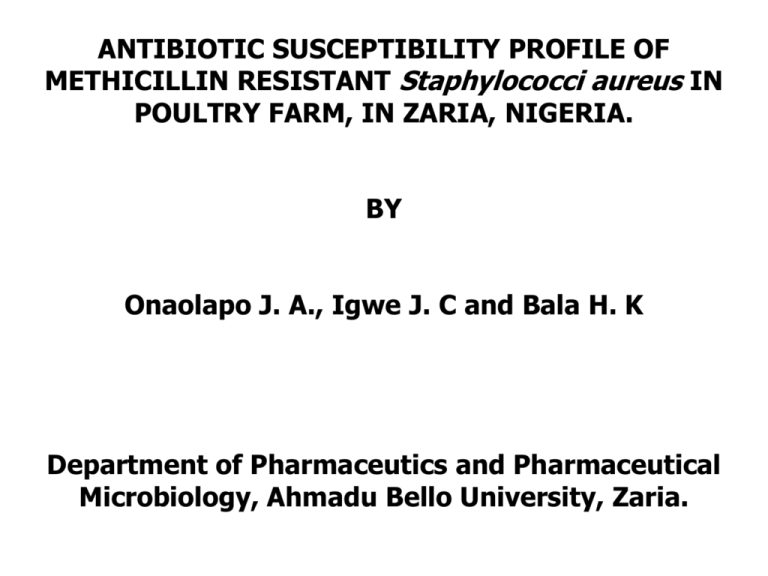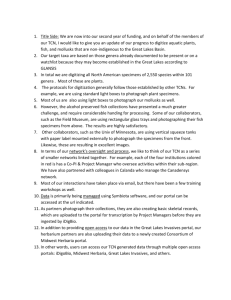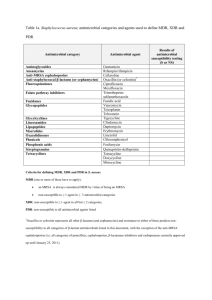ANTIBIOTIC SUSCEPTIBILITY PROFILE OF METHICILLIN
advertisement

ANTIBIOTIC SUSCEPTIBILITY PROFILE OF METHICILLIN RESISTANT Staphylococci aureus IN POULTRY FARM, IN ZARIA, NIGERIA. BY Onaolapo J. A., Igwe J. C and Bala H. K Department of Pharmaceutics and Pharmaceutical Microbiology, Ahmadu Bello University, Zaria. PRESENTATION OUTLINE • Introduction • Methodology • Results and Discussion • Conclusion • Recommendations • References INTRODUCTION • Methicillin resistant Staph. aureus (MRSA) is a notorious pathogenic microorganism even in poultry. • This strain of Staph. aureus do not just produce βlactamases but also posses mobile genetic element known as staphylococcal cassette chromosome mec (SCCmec) (Garcia-Alverez et al., 2011). • That are predominantly present in coagulase-negative staphylococci (CNS), which carries mecA gene and encodes for an altered penicillin-binding protein (PBP2a or PBP2’) (Cohn and Middleton, 2010). • The PBP2a according to Sarah and Robert, (2010) has a lower affinity for β-lactam antimicrobials than the normal PBP such that these antimicrobials are deactivated. • MRSA also contains additional insertional DNA sequences that allow for incorporation of additional antimicrobial resistance markers (George, 2009), which enables it to develop resistance to non-β-lactam. • Staph. aureus with this characteristics could also produce virulent toxins and acquire antibiotics resistant genes to create a huge economic burden (Huber et al., 2010), influence livestock management, treatment of diseases and reduce productivity. RESEARCH AIM • This study evaluate the impact of Live stock Associated Methicillin Resistant Staph. aureus on the commonly prescribed antibiotics in Zaria, Nigeria in other to curb resistance spread through the provision of information for surveillance purpose. JUSTIFICATION OF RESEARCH PROBLEM • Phenotypic and genotypic indistinguishable MecA gene found in dairy, pig, cat, poultry, cattle and even in poultry farm workers suggests a cross-species transmission and Community acquisition of MecA gene of livestockassociated MRSA (LA-MRSA) (Juhasz-Kaszanyitzky, 2007 and Hasman et al., 2010). • This is possible either by contact or indirectly via the food chain; water, air, manure and sludge-fertilized soils (Cohn and Middleton, 2010; Huber et al., 2010), which could be endemic in rural area with low medical facilities in zoonotic disease outbreak (Vanderhaeghen et al., 2010). METHODOLOGY • Sample Collection • Fifty (50) samples of fresh chicken droplets were collected aseptically into a clean sterile universal bottle from five poultry farms (Hanwa new extension, Kongo, Zangon, A.B.U staff quarters Samaru, Dakace quarters) located in Zaria metropolis and were transported on an ice park to the laboratory for bacteriological examination. Staph. Species Identification, Isolation and Microscopy • Collected chicken droplets were suspended in sterile normal saline for 24hrs and then inoculated on the surface of sterile nutrient agar (NA), and incubated at 37OC for 18hrs. Gram staining and microscopy was also carried out to identify Gram positive organisms while further morphological characterization of the colonies isolated from concentrated Mannitol salt agar organism was carried out using the method described by Cheesbrough (2000). Biochemical Test and β-Lactamase Production Test. • The following conventional biochemical tests; catalase, coagulase and deoxyribonuclease (DNase) tests as described by Cheesbrough (2000) were also adopted to distinguish Staph. aureus from other forms of Staph. spp. Test tube method according to Lennette et al., (1990) and Plate-acidimetric method according to Cheesbrough (2000) were also used to determine the ability of the identified Staph. aureus to produce β-lactamase Antibiotic Susceptibility Test and Multiple Antibiotic Resistance Index (MARI) Evaluation • The susceptibility profiles of the identified Staph. aureus was tested against eight selected antibiotics (ampicillin, ciprofloxacillin, methicillin, tetracycline, Vancomycin, gentamicin, pefloxacin and oxacillin) using disc diffusion method as described by Cheesbrough (2000) and the corresponding results interpreted using CLSI (2014). The multiple antibiotic resistant (MAR) index was determined for each isolate. This is defined as the number of antibiotics to which the organism is resistant to, divided by the total number of antibiotics tested (Paul et al., 1997). Minimum Inhibitory Concentration (MIC) to Oxacillin • Resistance to methicillin was confirmed by the determination of the MIC of Oxacillin to the isolates. A working stock solution of 128µg/ml was prepared. This working solution (2ml) was then serially diluted in nutrient broth (2ml) up to the last tube. Eighteen hours cultures of the isolates were standardized to contain about 106cfu/ml inoculum size. The diluted antibiotic was aseptically inoculated with 1-2 drops of the standardized inoculum. The test tubes were inoculated at 35oC for 18hrs and this was repeated for all the resistant isolates Determination of Vancomycin Resistance • Isolates that were resistant to oxacillin from the minimum inhibitory concentration results were picked for this test. • Fresh stock solution of 4µg/ml and 6µg/ml of Vancomycin were prepared. • Five millilitre (5ml) of the stock solution (4µg/ml) were aseptically mixed with sterilized mannitol salt agar and distribute into petri-dish and allowed to solidify. • The dried agar surface was inoculated with the standard inoculum of the test isolates by streaking and incubated at 37OC for 24-48hrs. • This was repeated for all the isolates. Brain heart infusion agar (BHI) was mixed with 6 µg/ml of Vancomycin and distributed into petri-dishes and allowed to solidify. • Overnight culture of the test isolates were standardized to an inoculum size of 106cfu/ml. • The plates were allowed to dry at room temperature and then incubated at 37OC for 24-48hrs. This was repeated for all the resistant isolates RESULT AND DISCUSSION • Sample collection and Identification of Staph. aureus Isolates • Out of the 250 chicken droplets collected,157 isolates showed the Gram positive characteristics of Staph. spp. while 98 of the isolates fermented mannitol to acid and produced golden yellow colouration within 24hrs of incubation. Table 1: Biochemical Characterization and β-Lactamase Production in isolated Staph. aureus The result showed the biochemical characteristics of the identified Staph. aureus from different farm sources. 1 Hanwa New Extension (n=15) Catalase Coagulase DNase β-lactamase +ve -ve +ve -ve +ve -ve Production +ve -ve 15 0 11 4 13 2 11 4 2 Kongo Quarters (n=21) 21 0 20 1 20 1 20 1 3 Dakace Quarters (n=22) 22 0 21 1 19 3 21 1 4 Zangon Shanu Behind Aviation 25 (n=25) 0 23 2 23 2 23 2 5 ABU Staff Quarters, Samaru 15 (n=15) Total Staph. aureus (n = 98) 98 0 13 2 13 2 13 2 0 88 10 88 10 88 10 S/N Sample Source (N = 5 Farms) N= number of farms, n = number of Staph. aureus from various farms in Zaria, metropolis 100 90.8 Resistance 90 80 76.2 74.7 Susceptibility 65.6 70 Percentages 72.2 58.8 57.6 60 50.449.6 50 42.4 41.2 40 30 34.4 25.3 23.9 27.8 20 9.2 10 0 Antibiotics Figure 1: Antibiotic Susceptibility Profile of Staph. aureus from Poultry Farms in Zaria, Nigeria Antibiotic Resistance Pattern • This study showed that the pattern of antibiotic resistance of Staph. aureus from poultry farms in Zaria, Nigeria varies from one isolate to another. • Most of the isolates were resistant to β-lactam and tetracyclines. • The isolates were also found to be 44.3% (39) multidrug resistant, 40.9% XDR while 14.8% were neither MDR nor XDR. • The multiple antibiotic resistance index (MARI) at ≥0.4 was observed to be high (60%), indicating an environment with pre-exposure to the antibiotics used in this study. • From all the farms evaluated 40% (35) of the Staph. aureus were observed to be resistant to methicillin antibiotics. This is shown in Table 2. Table 2: Antibiotic Resistant Pattern and MARI of Staph. aureus from Poultry Farms in Zaria, Nigeria S/N Lab Code Antibiotic Resistant Pattern NAR GAR MDR MARI Farm 1 (Hanwa New Extension) 1 H7 Amp, Met, Ox, Pef, Tcn, Van 6 Bt, Flu, Tet, Gp MDR 0.8 2 H9 Amp, CN, Met, Ox, Tcn, Van 6 Bt, Ami, Tet, Gp MDR 0.8 3 H10 Amp, CN 2 Bt, Ami XDR 0.3 4 H18 Amp, Tcn 2 Bt, Tet XDR 0.3 5 H19 Met, Ox, Tcn, Van 4 Bt, Tet, Gp MDR 0.5 6 H25 CN, Met, Tcn 3 Bt, Ami, Tet MDR 0.4 7 H32 Cip, Met, Pef, Tcn 4 Bt, Flu, Tet MDR 0.5 8 H40 Amp, Ox, Tcn 3 Bt, Tet XDR 0.4 9 H45 Amp, Tcn 2 Bt, Tet XDR 0.3 10 H49 CN, Met, Tcn 3 Bt, Ami, Tet MDR 0.4 11 H50 Ox, Tcn 2 Bt, Tet XDR 0.3 Farm 2 (Kongo Quarters) 12 K53 Amp, CN, Met, Ox, Pef, Tcn. 13 K55 Amp, Pef. 14 K58 Amp, Ox, Tcn 15 K59 Amp, Met, Ox 16 K60 Amp, Met, Ox 17 K61 CN, Ox, Tcn, Van 18 K62 Met, Ox, Tcn, Van 19 K63 Cip, Pef. 20 K64 Met 21 K68 Met, Pef, Tcn 22 K70 Cip, CN, Tcn, Van 23 K71 Amp, CN, Met, Pef, Tcn 24 K72 CN 25 K75 Amp, Met, Pef, Tcn 26 K77 Tcn 27 K78 CN, Tcn, Van 28 K79 CN, Tcn, Van 29 K82 Amp, Met, Ox, Tcn, Van 30 K84 Amp, Tcn 31 K97 Amp, Tcn 6 2 3 3 3 4 4 2 1 3 4 5 1 4 1 3 3 5 2 2 Bt, Ami, Flu, Tet Bt, Flu Bt, Tet Bt Bt Bt, Ami, Tet, Gp Bt, Tet, Gp Flu Bt Bt, Flu, Tet Flu, Ami, Tet, Gp Bt, Ami, Flu, Tet Ami Bt, Flu, Tet Tet Ami, Tet, Gp Ami, Tet, Gp Bt, Tet, Gp Bt, Tet Bt, Tet MDR XDR XDR Nil Nil MDR MDR Nil Nil MDR MDR MDR Nil MDR Nil MDR MDR MDR XDR XDR 0.8 0.3 0.4 0.4 0.4 0.5 0.5 0.3 0.1 0.4 0.5 0.6 0.1 0.5 0.1 0.4 0.4 0.6 0.3 0.3 Farm 3 (D = Dakace Quarters) 32 D105 Met, Ox, Pef, Tcn, Van 33 D108 Ox, Tcn 34 D109 CN, Met, Ox, Tcn, Van 35 D115 Met, Ox, Tcn, Van 36 D117 Cip, Met, Tcn, Van 37 D119 Amp, Cip, Met, Pef, Tcn 38 D124 Amp, Ox, Tcn, Van 39 D127 Amp 40 D129 CN, Pef, Tcn 41 D130 CN, 42 D131 Amp, CN 43 D132 CN, Pef, 44 D133 Met, Ox, Tcn 45 D134 Amp 46 D136 Amp, CN, Met, Van 47 D139 Amp, CN, Pef, 48 D141 Amp, Pef, 49 D143 Amp, Tcn 50 D144 Amp, CN, Ox, Pef, Tcn, 51 D149 Amp, Cip, CN, Ox, Tcn, Van 5 2 5 4 4 5 4 1 3 1 2 2 3 1 4 3 2 2 5 6 Bt, Flu, Tet, Gp Bt, Tet Bt, Ami, Tet, Gp Bt, Tet, Gp Bt, Flu, Tet, Gp Bt, Flu, Tet Bt, Tet, Gp Bt Ami, Flu, Tet Ami Bt, Ami Ami, Flu Bt, Tet Bt Bt, Ami, Gp Bt, Ami, Flu Bt, Flu Bt, Tet Bt, Ami, Flu, Tet Bt, Flu, Ami, Tet, Gp MDR XDR MDR MDR MDR MDR MDR Nil MDR Nil XDR XDR XDR Nil MDR MDR XDR XDR MDR MDR 0.6 0.3 0.6 0.5 0.5 0.6 0.5 0.1 0.4 0.1 0.3 0.3 0.4 0.1 0.5 0.4 0.3 0.3 0.6 0.8 Farm 4 (Z = Zangon Shanu Behind Aviation) 52 Z151 Amp, Met, Ox, Tcn, Van 53 Z152 Tcn, Van 54 Z153 Amp, Ox, Tcn, 55 Z158 Amp, Met, Pef, 56 Z161 Amp, Met, Pef, Tcn 57 Z162 Amp, Tcn, 58 Z163 Met, Ox, Tcn 59 Z164 Amp, CN, Met, Tcn 60 Z165 Amp, Met, Ox, Tcn 61 Z169 Pef, Tcn 62 Z170 Cip, Pef, Tcn 63 Z173 Amp, CN, Ox, Pef, Tcn, Van 64 Z178 CN, Ox, Tcn, Van 65 Z180 Amp, Ox, Tcn 66 Z182 CN, Ox, Tcn, 67 Z185 CN, Pef 68 Z187 Amp 69 Z188 Cip, Met, Tcn 70 Z191 CN, Ox 71 Z192 Cip, Tcn 72 Z193 Met, Tcn 73 Z196 Amp, Tcn 5 2 3 3 4 2 3 4 4 2 3 6 4 3 3 2 1 3 2 2 2 2 Bt, Tet, Gp Tet, Gp Bt, Tet Bt, Flu Bt, Flu, Tet Bt, Tet Bt, Tet Bt, Ami, Tet Bt, Tet Flu, Tet Flu, Tet Bt, Ami, Flu, Tet, Gp Bt, Ami, Tet, Gp Bt, Tet Bt, Ami, Tet Ami, Flu Bt Bt, Flu, Tet Bt, Ami Flu, Tet Bt, Tet Bt, Tet MDR XDR XDR XDR MDR XDR XDR MDR XDR XDR XDR MDR MDR XDR MDR XDR Nil MDR XDR XDR XDR XDR 0.6 0.3 0.4 0.4 0.5 0.3 0.4 0.5 0.5 0.3 0.4 0.8 0.5 0.4 0.4 0.3 0.1 0.4 0.3 0.3 0.3 0.3 Farm 5 (A = ABU Staff Quarters, Samaru) 76 A201 Amp, CN, Met, Ox, Tcn 77 A202 Amp, Met, Ox, Pef, Tcn 78 A205 Amp, Ox, Tcn 79 A209 Amp, Pef, 80 A211 Tcn 81 A215 Met, Ox, Tcn 82 A220 CN, Met, Ox, Tcn, Van 83 A222 CN, Tcn 84 A230 Amp, CN, Pef 5 5 3 2 1 3 5 2 3 Bt, Ami, Tet Bt, Flu, Tet Bt, Tet Bt, Flu Tet Bt, Tet Bt, Ami, Tet, Gp Ami, Tet Bt, Ami, Flu MDR MDR XDR XDR Nil XDR MDR XDRz MDR 0.6 0.6 0.4 0.3 0.1 0.4 0.6 0.3 0.4 85 86 87 88 2 3 2 2 Bt Bt, Flu, Tet Bt, Tet Bt Nil MDR XDR Nil 0.3 0.4 0.3 0.3 A234 A235 A240 A245 Amp, Met Ox, Pef, Tcn Amp, Tcn Amp, Ox, Keys: Amp = ampicillin, Cip = Ciprofloxacillin, Met = Methicillin, Tcn = tetracycline, Van = Vancomycin, CN = gentamicin, Pef = pefloxacin and Ox = oxacillin, Bt = β-lactams, Gp = Glycopeptides, Ami = Aminoglycoside, Tet = Teteracycline, Flu = Fluoroquinolone, NAR = Number of antibiotics resistant to, GAR = Groups of antibiotics resistant to, MDR = Multidrug resistant, MARI = Multiple antibiotics resistant index. MDR: Multidrug-resistant, XDR: Extensively drug-resistant NIL: neither MDR nor XDR. MDR: non-susceptible to ≥1 agent in ≥3 antimicrobial categories. XDR: non-susceptible to ≥1 agent in all but ≥2 categories. PDR: non-susceptible to all antimicrobial agents listed. PDR was not considered because not all the antibiotics contained in the proposal of Magiorakos et al., (2012) are used in poultry management in Zaria, Nigeria. Minimum Inhibitory Concentration (MIC) to Oxacillin • The result of the MIC of oxacillin against the 35 isolates that were resistant to methicillin showed that 74.3% of the isolates had high MIC ≥ 64µg/ml and the remaining 25.7% had MIC of 2µg/ml. • This is as shown in Table 3. The MIC break points for oxacillin are MIC of ≤ 2µg/ml is susceptible while that of ≥ 4 µg/ml is resistant. Table 3: Minimum Inhibitory Concentration (MIC) of Methicillin Resistant Staph. aureaus from Poultry Farm in Zaria, Nigeria to Oxacillin S/N Isolates MIC S/N Isolates MIC 1 19 ≥ 64 19 115 ≥ 64 2 25 ≥ 64 20 117 ≥ 64 3 32 ≥ 64 21 119 ≥ 64 4 40 ≥ 64 22 124 ≤2 5 49 ≥ 64 23 133 ≥ 64 6 50 ≥ 64 24 136 ≤2 7 8 53 58 ≤2 ≥ 64 25 26 151 153 ≥ 64 ≥ 64 9 10 11 59 60 61 ≤2 ≤2 ≥ 64 27 28 29 158 161 163 ≥ 64 ≥ 64 ≥ 64 12 62 ≥ 64 30 164 ≥ 64 13 64 ≥ 64 31 165 ≥ 64 14 68 ≥ 64 32 188 ≥ 64 15 71 ≥ 64 33 193 ≥ 64 16 75 ≥ 64 34 201 ≤2 17 18 78 82 ≤2 ≤2 35 205 ≤2 Determination of Vancomycin Resistance • The 74.3% (26) isolates that showed high MIC value against Oxacillin were tested against Vancomycin. • The result showed that 80.8% (21) of the isolates were resistant to Vancomycin while 19.2% (5) were sensitive even after 48hrs incubation on mannitol salt agar impregnated with 4µg/ml Vancomycin. • The isolates were also grown on Brain heart infusion agar impregnated with 6µg/ml Vancomycin. The result showed that 88.5% (23) of the isolates were resistant while 21.5% (3) were sensitive. This is shown in Table 4 Table 4: Vancomycin Resistance in Staph. aureus from Poultry Farms in Zaria, Nigeria S/N Isolates 2µg/ml Vancomycin 1 19 2 25 3 32 4 40 5 49 6 50 7 58 8 61 9 62 10 64 11 68 12 71 13 75 14 115 15 117 16 119 17 124 18 133 19 151 20 153 21 158 22 161 23 163 24 164 25 165 Key:26 + = resistance, 193- = susceptible + + + + + + + + + + + + + + + + + + + + + + + + + + 4µg/ml Vancomycin 6µg/ml Vancomycin + + + + + + + + + + + + + + + + + + + + + + + + + + + + + + + + + + + + + + + + + + + + CONCLUSION • Methicillin-resistant Staph. aureus (MRSA), once restricted to hospitals is spreading rapidly in poultry farms in Zaria, Nigeria and this could play a potential role in disseminating pathogens between animal and human resulting into community acquired MRSA. • This study established the first complete Staph. aureus isolates to be Vancomycin resistanct with an elevated Vancomycin MIC within the susceptible range in Zaria, Nigeria among poultry farms. • It also showed that MRSA is able to develop Vancomycin resistance, in which the spread of this resistant trait might influence untreatable diseases in zoonotic outbreak. RECOMMENDATIONS • To improve the efficacy of Vancomycin therapy we suggest a further study on the combination of Vancomycin with Ciprofloxacin or Gentamicin, or Pefloxacin to infections associated with highly resistant MRSA. • Also antibiotic surveillance and control on the use of beta-lactam antibiotics including other classes of antibiotics in our community should be emphasized. • • • • • REFERENCE Cheesbrough M. (2000). District Laboratory Practice in Tropical Countries,Part 2. Cambridge University Press: 135-142, 158-159 Clinical Laboratory Standard Institute (CLSI) (2014). Performance Standards for Antimicrobial Susceptibility Testing; Twenty-Fourth. This document provides updated tables for the Clinical and Laboratory Standards Institute antimicrobial susceptibility testing standards M02-A11, M07-A9, and M11-A8. 30(1) Cohn L.A. and J.R. Middleton (2010). A veterinary perspective on methicillin-resistant staphylococci. J. Vet. Emerg. Crit. Care. 20:31-45. Garcia-Alverez, L., M.T.G. Holden, H. Lindsey, C.R. Webb, D.F.J. Brown, M.D. Curran, E. Walpole, K. Brooks, D.J. Pickard, C. Teale, J. Parkhill, S.D. Bentley, G.F. Edwards, E.K. Girvan, W.M. Kearns, B. Pichon, R.L.R. Hill, A.R. Larsen, R.L. Skov, S.J. Peacock, D.J. Maskell, and M.A. Holmes (2011). Methicillin-resistant Staphylococcus aureus with a novel mecA homologue in human and bovine populations in the UK and Denmark: a descriptive study. Lancet Infect. Dis. George Y. Liu (2009). Molecular Pathogenesis of Staphylococcus aureus Infection. Pediatr Res. 65(2-5): 71–77. • Hasman H., A. Moodley, L. Guardabassi, M. Stegger, R.L. Skov, F.M. Aarestrup (2010). spa type distribution in Staphylococcus aureus originating from pigs, cattle and poultry. Veterinary Microbiology, 141(3-4): 326-331 • Huber H, Koller S, Giezendanner N, Stephan R, Zweifel C. (2010). Prevalence and characteristics of meticillin-resistant Staphylococcus aureus in humans in contact with farm animals, in livestock, and in food of animal origin, Switzerland, 2009. Euro Surveill.,15(16):19542 • Juhasz-Kaszanyitzky, E., S. Janosi, P. Somogyi, A. Dan, L. van der Graaf-av Bloois, E. van Duijkeren, J.A. Wagenaar (2007. MRSA transmission between cows and humans. Emerg. Infect. Dis. 13:630-632. • Lennette, E.H., Balones, P., Hausa, W.J., Shadonmu, H.J. (1990). Manual of Clinical Microbiology,Washington DC. Pp. 10-20 • Paul, S. Bezbarauh, R.L. Roy, M. K and Ghosh, A.C. (1997). Multiple antibiotics resistance (MAR) index and its reversion in Pseudomomas aeruginosa. Letters in Applied Microbiology, 24:169-71 • Quinn P.J., M.E. Carter, B.K. Markey, G.R. Carter (2000). Staphylococcus species. Clinical Veterinary Microbiology Mosby, Edinburgh. Pp. 118–126 • Sarah M. Drawz and Robert A. Bonomo (2010). Three Decades of β-Lactamase Inhibitors. Clin Microbiol Rev.; 23(1): 160–201. THANKS FOR LISTENING






